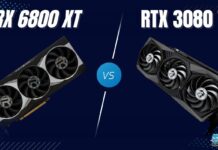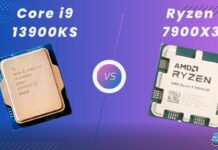AMD and Nvidia are in active battle again following the launch of Nvidia’s RTX 4000 series cards. However, today, we’re jumping back a few years to compare the Radeon RX 6600 vs GeForce RTX 2060. Which card is better? Let’s find out.
Key Takeaways
- In our gaming tests, the AMD Radeon RX 6600 showcased remarkable performance, outperforming the GeForce RTX 2060 by a significant 26% in 1080P gaming scenarios.
- AMD Radeon RX 6600 is approximately 25% cheaper than the GeForce RTX 2060. It is also more power efficient.
- After conducting our own tests, we found that the Radeon RX 6600 runs slightly hotter, about 8.5% warmer, than the GeForce RTX 2060.
Comparison Table
| Technical Specs | GeForce RTX 2060 | Radeon RX 6600 |
| GPU Name | TU106 | Navi 23 |
| Architecture | Turing | RDNA 2.0 |
| Transistors | 10,800 million | 11,060 million |
| Shading Units | 1920 | 1792 |
| Tensor Cores | 240 | NA |
| RT Cores | 30 | 28 |
| TMUs | 120 | 112 |
| ROPs | 48 | 64 |
| L1 Cache | 64 KB (per SM) | 128 KB per Array |
| L2 Cache | 3 MB | 2 MB |
| Memory Bus Width | 256 bit | 128 bit |
| Memory Bandwidth | 336.0 GB/s | 224.0 GB/s |
| Suggested PSU | 450W | 300W |
| Release Date | Jan 7th, 2019 | Oct 13th, 2021 |
| Approximated Price | 360 USD | 320 USD |
Architecture Differences
- Process Node: The RTX 2060 is built on a 12nm process node, whereas the RX 6600 utilizes a more advanced 7nm process, which often translates to improved efficiency and performance.
- Clock Speed: The RTX 2060 features a 1365 MHz Base Clock and 1680 MHz Boost Clock, while the RX 6600 boasts a 1626 MHz Base Clock and an impressive 2491 MHz Boost Clock, indicating potentially faster in-game performance for the RX 6600.
- VRAM: The RTX 2060 comes equipped with 6GB of GDDR6 VRAM, while the RX 6600 offers a more generous 8GB of GDDR6 VRAM, providing better support for modern games and higher resolutions.
- TDP: The RTX 2060 has a TDP of 160W, whereas the RX 6600 is notably more power-efficient with a TDP of 132W. This can lead to lower power consumption and potentially less heat generation.
- Supported Technologies: While the RTX 2060 features DLSS (Deep Learning Super Sampling) for AI-enhanced gaming, the RX 6600 also includes FidelityFX Super Resolution (FSR), AMD’s counterpart, offering a balance between image quality and performance
RX 6600 Vs RTX 2060 Gaming Benchmarks
Next, let’s compare the gaming performance of the two graphics cards. It’s important to remember that these figures may be slightly inaccurate due to the use of external software for monitoring. With that out of the way, let’s look at the test bench:
Test Bench
- OS: Windows 11
- CPU: Intel Core i7-13700K
- Motherboards: ASRock Z790 Taichi Lite Motherboard
- RAM: Kingston Fury Renegade RGB DDR5 32GB 7200MHz
- SSD: XPG GAMMIX S70 BLADE 2TB NVMe SSD
- PSU: Enermax Revolution D.F. X 1050W
- CPU Cooler: MSI MAG CORELIQUID E360 CPU Liquid Cooler
Mafia: Definitive Edition
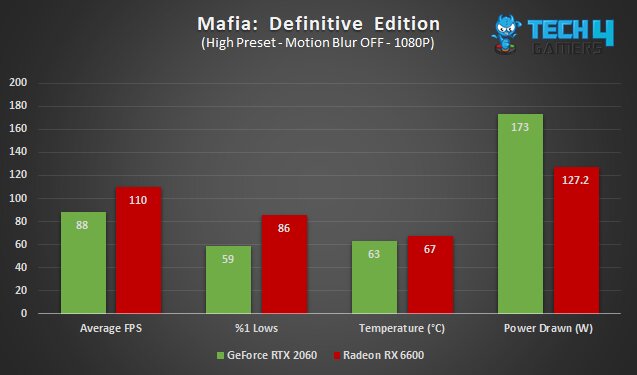
- In our own testing, we found that the Radeon RX 6600 outperformed the GeForce RTX 2060 by a significant 25% in terms of average FPS when playing Mafia: Definitive Edition.
- Radeon RX 6600’s lead increases even further to 45.7% in terms of the %1 lows, with the Radeon RX 6600 scoring 86 FPS and GeForce RTX 2060 managing only 59 FPS.
- The GeForce RTX 2060 is the better GPU in terms of temperatures, hitting 63°C on average, while the Radeon RX 6600 runs slightly hotter at 67°C.
- From our tests, we discovered that the GeForce RTX 2060 consumes a considerable 173 watts of power, while the Radeon RX 6600 operates more efficiently, drawing just 127.2 watts.
Hitman 3
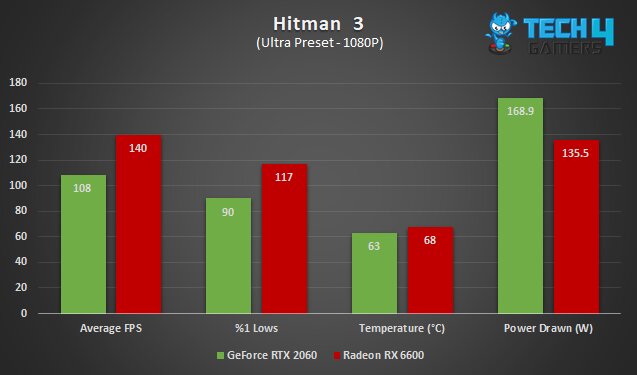
- Our extensive testing clearly shows the AMD Radeon RX 6600 taking the lead in Hitman 3, achieving an impressive average of 140 FPS, surpassing the GeForce RTX 2060’s 108 FPS.
- Our testing results indicate that the Radeon RX 6600 excels in %1 lows, delivering a solid 117 FPS, while the GeForce RTX 2060 lags behind at 90 FPS in this aspect.
- The GeForce RTX 2060 again runs cooler, by 5°C, compared to the Radeon RX 6600.
- The GeForce RTX 2060, again, hits the ceiling in terms of power draw, utilizing 168.9 watts. The Radeon RX 6600 only utilizes 135.5 watts.
Assassin’s Creed: Valhalla
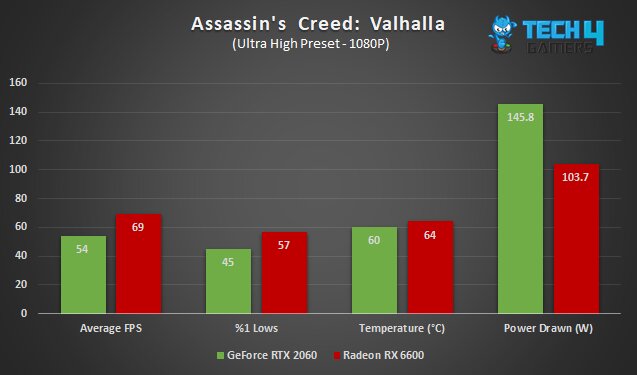
- Our comprehensive tests show that Assassin’s Creed: Valhalla is demanding for the GeForce RTX 2060, as it struggles to maintain an average of under 60 FPS. In contrast, the Radeon RX 6600 impressively maintains an average of 69 FPS in this game.
- The %1 low figures tell the same story, with the Radeon RX 6600 taking a 26% lead.
- Our testing indicates that, on average, the GeForce RTX 2060 runs 4°C cooler than the Radeon RX 6600. This may be a consideration for users who prioritize lower operating temperatures in their graphics card choices.
- Another big contrast between the two cards in terms of average power draw. The GeForce RTX 2060 draws 145.8 watts, and the Radeon RX 6600 draws 103.7 watts.
Red Dead Redemption 2
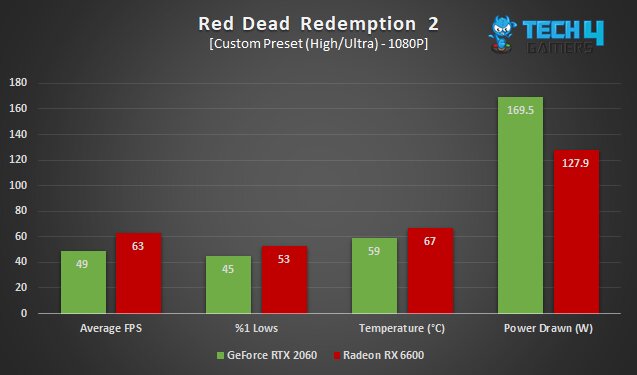
- The GeForce RTX 2060 is again seen struggling, managing only 49 FPS on average. The Radeon RX 6600 leads with 63 FPS, a 28.5% lead.
- In our extensive testing and analysis, the Radeon RX 6600 consistently outperformed the GeForce RTX 2060 in terms of %1 lows, with the Radeon RX 6600 maintaining a more impressive 53 FPS compared to the GeForce RTX 2060’s 45 FPS.
- The Radeon RX 6600 scores better FPS at the cost of drawing more heat, running 8°C hotter on average.
- Based on our benchmark results, we found that the RTX 2060 draws significantly more power, with a consumption of 169.5 watts. In comparison, the Radeon RX 6600 demonstrated a more power-efficient profile with a consumption of 127.9 watts.
Microsoft Flight Simulator
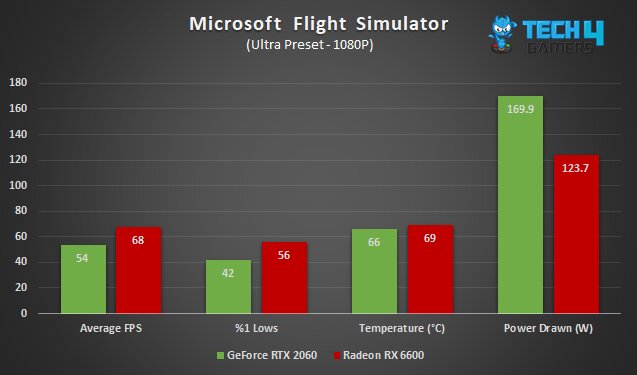
- Microsoft Flight Simulator poses yet another challenge for the GeForce RTX 2060, which records 54 FPS on average. The Radeon RX 6600 averages 68 FPS.
- Based on our rigorous testing, the Radeon RX 6600 secured a remarkable 56 FPS for the %1 low, significantly outperforming the GeForce RTX 2060, which achieved 42 FPS in the same scenario.
- In our own benchmarking, we observed that the GeForce RTX 2060 maintained an average temperature of 66°C, while the Radeon RX 6600 recorded a slightly warmer 69°C, reflecting a 4.5% temperature difference in favor of the RTX 2060.
- The GeForce RTX 2060 draws 37.3% more power on average compared to the Radeon RX 6600.
Horizon Zero Dawn
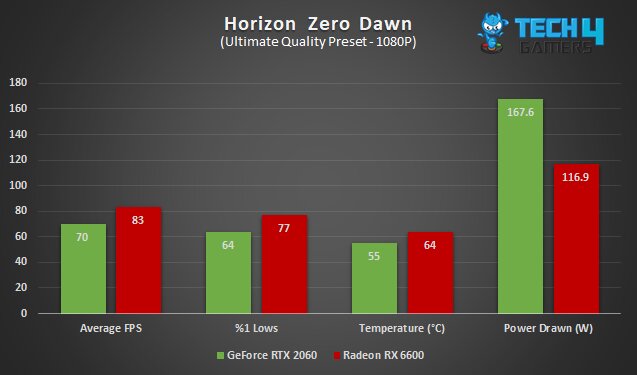
- The Radeon RX 6600 bags another win with 83 FPS on average, beating the GeForce RTX 2060 by 18.5%.
- In terms of %1 lows, the Radeon RX 7700 notches 77 FPS, and the GeForce RX 2060 trails with 64 FPS.
- Based on our own tests, the Radeon RX 6600 runs noticeably hotter at an average temperature of 64°C, while the GeForce RTX 2060 maintains a cooler, operating at 55°C on average. This results in a significant 16.1% difference in favor of the RTX 2060.
- Our tests have shown that the power draw of the GeForce RTX 2060 remains high, consuming a substantial amount of 169.5 watts, which is 45.4% more than the more power-efficient Radeon RX 6600, which draws 116.9 watts.
Forza Horizon 4
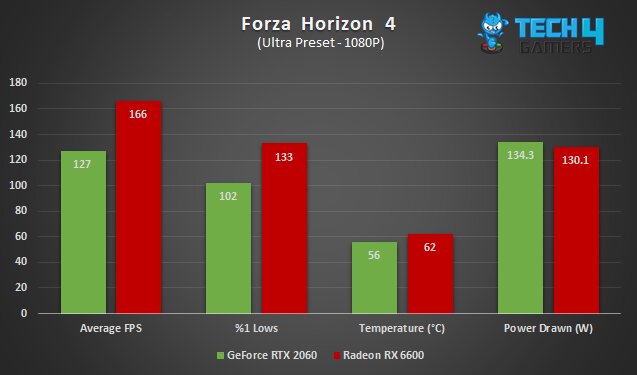
- In our own extensive tests, we found that the RX 6600 excels in Forza Horizon 4, achieving an impressive average of 166 FPS. In contrast, the RTX 2060 lags behind with an average of 127 FPS.
- The Radeon RX 6600 scores 133 FPS as far as the %1 low is concerned, and the GeForce RTX 2060 falls behind again with 102 FPS.
- Based on our thorough testing, the GeForce RTX 2060 maintains an average operating temperature of 56°C, which is notably cooler than the Radeon RX 6600, averaging around 62°C.
- The Forza Horizon 4 benchmark sees the two graphics cards drawing comparable amounts of power, only differing by 3%.
Far Cry 6
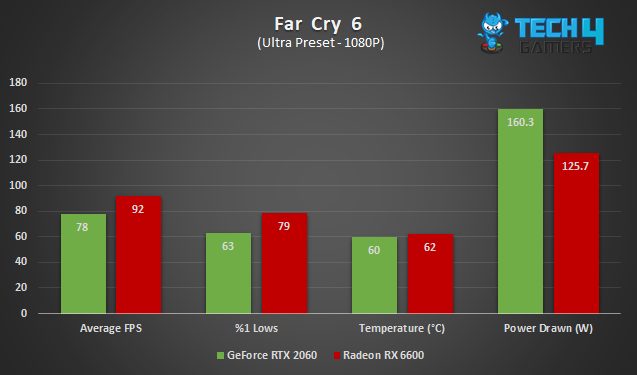
- Nvidia’s RTX lags behind the Radeon RX 6600, averaging 78 FPS in Far Cry 6, and the Radeon RX 6600 scores 92 FPS.
- In our comprehensive testing, we found that the Radeon RX 6600 outperforms the GeForce RTX 2060 when it comes to %1 lows. The Radeon RX 6600 achieved an impressive 79 FPS in this category, while the GeForce RTX 2060 falls behind at 63 FPS.
- A minor difference of 2°C is recorded between the two cards as far as the average temperature is concerned.
- Our tests have revealed a significant difference in power consumption between the two cards. The GeForce RTX 2060 draws a substantial 160.3 watts, while the Radeon RX 6600 proves to be more power-efficient, consuming only 125.7 watts.
Days Gone
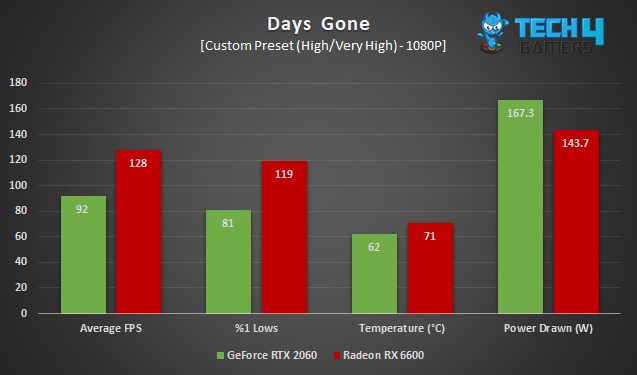
- In our tests, the Radeon RX 6600 outperforms the GeForce RTX 2060 by a significant margin in Days Gone. The Radeon RX 6600 achieves an average frame rate of 128 FPS, while the GeForce RTX 2060 lags behind with only 92 FPS.
- Not much difference when it comes to %1 lows – the GeForce RTX 2060 scores 81 FPS, and the Radeon RX 6600 is at a much higher 119 FPS.
- During our benchmarks, we observed another substantial difference in average temperature. The Radeon RX 6600 runs at a higher temperature of 71°C, while the GeForce RTX 2060 maintains a cooler temperature of 62°C.
- Our benchmarks reveal that there is a notable contrast in the average power drawn between the RX 6600 and the RTX 2060. Once again, the RTX 2060 draws higher amounts of power compared to its AMD counterpart, the RX 6600.
Cyberpunk 2077
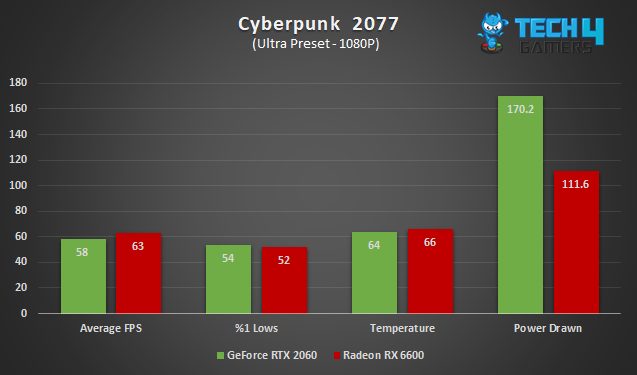
- The two cards don’t show a big difference in terms of average FPS here – an 8.6% difference is seen.
- Our tests also revealed a minor difference in the %1 lows, with the Radeon RX 6600 achieving an average of 79 FPS and the GeForce RTX 2060 slightly behind at 76 FPS.
- In our tests, we found that the average temperatures of the two cards were quite similar. The GeForce RTX 2060 operated at 64°C, while the Radeon RX 6600 ran at a slightly higher temperature of 66°C.
- The power draw, on the other hand, poses a significant concern for the GeForce RTX 2060. It draws 52.5% more power, in exact!
Overall Gaming Performance
Let’s look at the mean of the average FPS recorded in each game during the RX 6600 vs RTX 2060 gaming benchmarks.
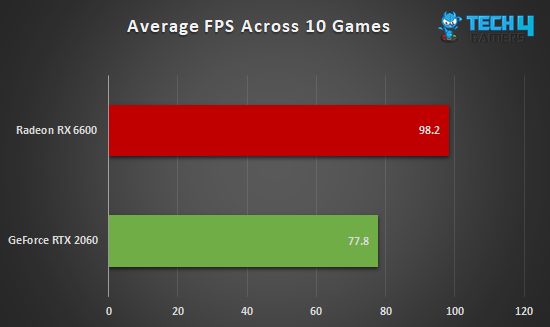
- AMD’s Radeon RX 6600 has a clear lead here, as it had a better average FPS in every title over the GeForce RTX 2060.
- In our extensive testing across a variety of games, the Radeon RX 6600 consistently outperformed the GeForce RTX 2060, securing an average of 98.2 FPS compared to the RTX 2060’s average of 77.8 FPS.
- Across the board, the Radeon RX 6600 showcases a substantial 26.2% performance advantage in 1080P gaming, cementing its position as a strong contender in this resolution.
Also Read: RTX 2060 Vs 3060
Average Power Drawn
Next up, let’s look at the average power drawn across the 10 tested titles. The Radeon RX 6600 has a TDP rating of 132 watts, and when it comes to the GeForce RTX 2060, it’s 160 watts. If you want to read more about the concept of TDP, be sure to check out our guide.
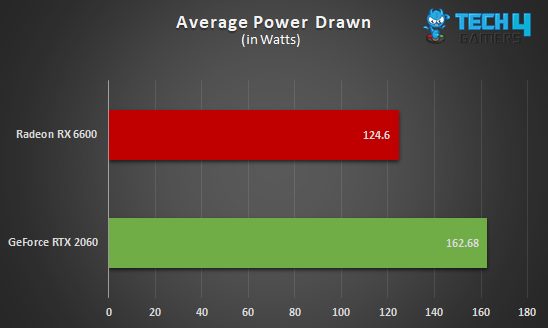
- Our extensive testing has consistently demonstrated the superior power efficiency of the Radeon RX 6600 compared to the GeForce RTX 2060 across all 10 benchmarks.
- The Radeon RX 6600 draws 124.6 watts on average, less than its TDP rating of 130 watts. The GeForce RTX 2060 draws 162.68 watts, slightly higher than its TDP rating.
- Our in-depth testing has revealed an impressive 30.6% greater power efficiency of the Radeon RX 6600 in comparison to the GeForce RTX 2060.
Average Temperature
Next, let’s look at the thermal performance of RX 6600 vs RTX 2060.
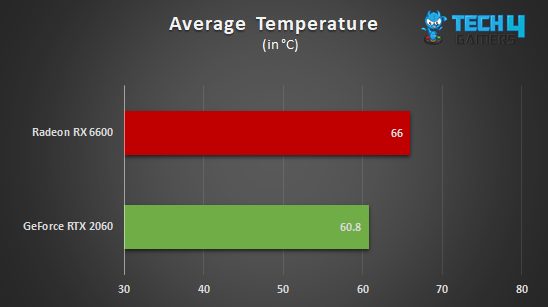
- Our tests show less contrast between the two graphics cards, with the Radeon RX 6600 running at 66°C on average. The thermal performance favors the GeForce RTX 2060, as it runs at a fairly cooler 60.8°C.
- Our extensive testing shows that the GeForce RTX 2060 maintains an 8.5% lower average operating temperature compared to the Radeon RX 6600.
You may want to read: How to Lower GPU Temperature?
RX 6600 Vs RTX 2060: Which One Would We Recommend?
- Our extensive testing revealed that the Radeon RX 6600 is a performance powerhouse, outpacing the GeForce RTX 2060 with a substantial 26.2% improvement in 1080P gaming. Gamers seeking top-tier performance will appreciate this advantage.
- We observed that the Radeon RX 6600 showcases remarkable power efficiency, surpassing the GeForce RTX 2060 by an impressive 30.6%. This not only results in a greener gaming experience but also reduces the strain on your wallet when it comes to electricity costs.
- During our extensive benchmarking, the GeForce RTX 2060 exhibited an 8.5% advantage in running cooler. This translates to a quieter and more comfortable gaming environment for enthusiasts who prioritize temperature management.
- Based on our comprehensive analysis, we found a substantial price difference of approximately 31.5% between these two GPUs. This financial distinction provides budget-conscious gamers with a clear value proposition.
Pros And Cons
| GPU | Pros | Cons |
| GeForce RTX 2060 |
|
|
| Radeon RX 6600 |
|
|
Similar Articles
Thank you! Please share your positive feedback. 🔋
How could we improve this post? Please Help us. 😔
[Hardware Reviewer]
Hi! I’m Ali Tauseef, and I have been writing for Tech4Gamers since 2022. I love all things computer hardware but am particularly fond of CPUs and motherboards, and I like to stay up-to-date about the latest advancements in these worlds, and when possible, write about it. When I’m not doing that, I like to get into a little FPS action in CS2 or get lost in the vast world of RDR2.
Get In Touch: ali@tech4gamers.com


 Threads
Threads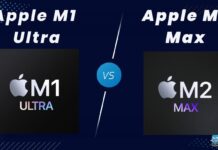
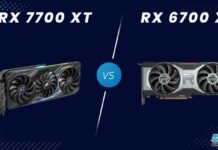
![Intel i9-12900K Vs. i9-12900KS [6 Games Tested]](https://tech4gamers.com/wp-content/uploads/2022/06/CPU-Comparison-Template-NEW-1-218x150.jpg)
